Inert Gas Generator
-
- Wartsila Delivers Combination Tanker xTavi' To Neste Oy Maritime Reporter, Feb 15, 1985 #42
The Turku shipyard of Oy Wartsila Ab recently completed the 19,999-dwt crude oil/chemical/ products tanker Tavi (shown above), first of two ordered by Neste Oy, the Finnish national oil company.
The vessel was delivered less than 14 months after keel-laying.
The Tavi is built to Lloyd's Register of Shipping classification +100 Al, Chemical Tanker, +LMC, UMS, IGS, Ice Class 1A. She is an IMO type II/III chemical tanker for worldwide trading of crude oil, oil products, and type II/III chemicals including benzene, styrene nonomer, caustic soda, caustic potaska, molasses, urea, white spirits, solvents, and alcohol. The cargo list comprises 72 different chemicals most widely transported by sea.
The tanker has an overall length of about 528 feet, beam of 76 feet, depth to upper deck of 46 Vi feet, and design draft of 33 feet. Propulsion is provided by a Wartsila/Pielstick 6PC4.2L-570 diesel engine coupled through a reduction gear to a KaMeWa controllable-pitch propeller.
The engine has a maximum continuous output of 9,776 bhp at 400 rpm. The ship is also fitted with controllable-pitch bow thruster driven by a 1,000-kw electric motor.
Three Wartsila-Vasa 6R22HF auxiliary diesels are direct-coupled u> Stromberg 935-kva alternators.
Main and auxiliary engines, boilers, and inert gas generator are all able to run with one kind of fuel on board—3,500 sec Redwood at 100 F.
The hull is divided, by two longitudinal and 11 transverse bulkheads, into 10 center tanks and eight side tanks for cargo, six side tanks for water ballast, and two slop tanks. Transverse bulkheads are stiffened by corrugating; longitudinal bulkheads are smooth in the center tanks with stiffeners in the side tanks. Center tanks are coated with pure epoxy; cargo side tanks are coated with zinc silicate.
Each cargo tank is fitted with a Thune Eureka deepwell pump. For cargo heating, 18 Sunrod heaters are installed on the main deck. One Maritime Protection inert gas generator is installed in a deckhouse aft. The generator has a capacity of 3,300 cubic meters per hour with a maximum pressure of 0.2 bar.
Despite being a ship less than 150 meters (492 feet) and of less than 20,000 dwt, the design of the Tavi incorporates some of the more severe requirements applicable to larger vessels. These include damage stability, segregated ballast water tanks, crude oil washing, and the inert gas system.
-
- Crude/Chemical/Products Tanker Delivered By Wartsila's Turku Yard Maritime Reporter, Oct 15, 1984 #30
.6 feet, and draft of 33.2 feet. Total cargo tank capacity (100% full) is 26,644 cubic meters. Main engines, auxiliary engines, boilers, and inert gas generator are all designed to run from start to stop on one grade of fuel oil—3,500 seconds Redwood at 100 F. The Wartsila/Pielstick 6PC4.21- 570
-
- Ballast Water Tech: N.E.I. Maritime Reporter, Feb 2013 #44
, and does not require changing ballast pumps due to flow restrictions. VOS leverages a highly efficient Stripping Gas Generator (similar to an Inert Gas Generator) to produce a very low oxygen gas (Stripping Gas). This gas is introduced to the ballast water via a Venturi Injector (VI). The VI generates
-
- Great Ships of 2014: Gas Star - 84,000 CBM LPG Carrier Maritime Reporter, Dec 2014 #54
three stage cargo compressors and motors are located on main deck in enclosed deck house. One cargo heater (combined with vapourizer) and one inert gas generator are provided. Three 1,140 kW diesel generators, one auxiliary boiler (3,000 kg/h), one exhaust gas economizer (1,500 kg/h) for the main engine
-
- Liquefied Gas Minicarrier Delivered By Moss Verft Maritime Reporter, Apr 1981 #23
compressors able to carry two cooled cargoes simultaneously. A combined inert gas/incinerator plant is installed in the engine room. The inert gas generator has a capacity of 500 cubic meters of nitrogen per hour. Both liquid and solid wastes can be burned in the incinerator. This combined plant
-
- First O f Five Parcel Tankers Delivered To Stolt By D a e w oo Maritime Reporter, Apr 1986 #11
features add to the versatility of these parcel tankers. The air dehumidification plant for moisture control, the nitrogen storage plant and inert gas generator, availability of cargo heating by thermal oil, hot water or steam (up to 230 F in certain tanks), and the Skarpenord computerized Cargo- master
-
- Moss Rosenberg Delivers First Of Three Chemical/Gas Carriers For Norwegian Owners Maritime Reporter, Oct 15, 1981 #12
radar sets with anticollision devices, gyro equipment, echosounder, satellite navigator, etc. A gas-detection system and a 900 Nm3/hr combined inert gas generator/incinerator have been installed. Both are designed and manufactured by Moss Verft
-
- OUTSTANDING OCEANGOING SHIPS OF 1984 Maritime Reporter, Dec 1984 #12
.6 feet, and draft of 33.2 feet. Total cargo tank capacity (100% full) is 26,644 cubic meters. Main engines, auxiliary engines, boilers, and inert gas generator are all designed to run from start to stop on one grade of fuel oil—3,500 seconds Redwood at 100 F. The Wartsila/Pielstick 6PC4.21- 570
-
- M/V Ogden Dynachem Christened At Avondale Maritime Reporter, Aug 15, 1981 #44
equipment, automatic high-level shutdown filling valves and stringent material restrictions. The vessel's fuel-efficient, closed-loop control inert gas generator is a low velocity displacement system with a common distribution header and check valve isolation into each cargo segregation. Independent
-
- Alfa Laval: New Test Facilities, New Technologies Maritime Reporter, May 2017 #66
pilot program, but guaranteeing the cargo’s safety and reliable availability was even more important: “The AFEM modification is part of the inert gas generator’s combustion control circuitry,” said Mart Blankert, Manager Customer Support, Inert Gas Systems at Alfa Laval. “A failed module could prevent
-
- Practical Compliance With Latest USCG and IMCO REGULATIONS Maritime Reporter, Aug 1981 #72
require- ments of the regulations requires modifications to the system. An inert gas system directs flue gas from existing boilers (or from an inert gas generator) through a scrubber unit, blower, and pressure regulating valve to suitable distribution piping located on the upper deck. A deck water
-
- GASTECH '84 Maritime Reporter, Oct 15, 1984 #18
the Low Countries. Visits include an inspection of the Wieringermeer compressor and blending station of N.V. Nederlandse Gasunie; a tour of the inert gas generator production and testing facilities of Smit Ovens Gas Generators (formerly Holec) at Nijmegen; and, crossing the Dutch frontier into Belgium
-
 )
March 2024 - Marine Technology Reporter page: 37
)
March 2024 - Marine Technology Reporter page: 37miscible barrier ? uid heavier than seawater (sg=1.026) and lighter than the battery electrolyte (sg=1.265). The original cell vent cap was screwed into the top of the riser pipe to vent the gases associated with charging. Wires were soldered to the lead (Pb) posts. The lead-acid battery was additionall
-
 )
March 2024 - Marine Technology Reporter page: 36
)
March 2024 - Marine Technology Reporter page: 36LANDER LAB #10 Of special interest for marine applications, LiPo batteries are Shipping any kind of lithium battery can be a challenge, and offered in a “pouch” design, with a soft, ? at body. The pouch IATA regs vary with the batteries inside or outside an instru- is vacuum-sealed, with all voids ?
-
 )
March 2024 - Marine Technology Reporter page: 25
)
March 2024 - Marine Technology Reporter page: 25Auerbach explained that ideally, “one ? ed layers of geothermal activity,” noted changes over an area of 8,000 km2. They would have both instruments: seismom- Skett, “and the change in salinity and dis- found up to seven km3 of displaced ma- eters to detect and locate subsurface ac- solved particles for
-
 )
April 2024 - Maritime Reporter and Engineering News page: 42
)
April 2024 - Maritime Reporter and Engineering News page: 42OPINION: The Final Word Seeing the Ship as a System Shipping must engage with the decarbonization realities that lie ahead by changing the way it crafts maritime legislation to re? ect its place in the interconnected, interdependent world economy, said Eero Lehtovaara, ABB Marine & Ports. ABB Marine &
-
 )
April 2024 - Maritime Reporter and Engineering News page: 38
)
April 2024 - Maritime Reporter and Engineering News page: 38Tech Files Latest Products, Systems and Ship Designs Zero-Emission Mooring Service of a Tanker Consulmar achieved a milestone by executing what it calls ing boat Castalia, which operates on full electric propulsion. the world's ? rst zero-emissions mooring service for a tanker. Equipped with two 150 kW
-
 )
April 2024 - Maritime Reporter and Engineering News page: 35
)
April 2024 - Maritime Reporter and Engineering News page: 35SIMULATION e have a close relationship with tech- Realism is prized beyond immersive, photo-realistic visu- nology, evidenced by, for example, als, and providers are introducing increasingly accurate func- the phones we are estimated to un- tionality. FORCE Technology’s upcoming DEN-Mark2 math- lock around
-
 )
April 2024 - Maritime Reporter and Engineering News page: 32
)
April 2024 - Maritime Reporter and Engineering News page: 32FEATURE A closeup of a blade installation process taken via drone. A blade handling system is apparent (in yellow). Images courtesy of Mammoet requirement for the development of these cranes, particularly ling area. This would result in a major time and fuel saving. in ? oating offshore wind,” says
-
 )
April 2024 - Maritime Reporter and Engineering News page: 25
)
April 2024 - Maritime Reporter and Engineering News page: 25RADM PHILIP SOBECK, MILITARY SEALIFT COMMAND Photo by Brian Suriani USN Military Sealift Command From a global supply chain perspective, What makes MSC so vital to the we’ve learned a lot about dealing with Navy’s ? eet and our military disruptions. COVID delivered a big forces around the world? wake-up
-
 )
April 2024 - Maritime Reporter and Engineering News page: 21
)
April 2024 - Maritime Reporter and Engineering News page: 21ROB LANGFORD, VP, GLOBAL OFFSHORE WIND ob Langford has worked in the offshore industry ABS. “We are growing and evolving our services across all for more than three decades, ‘cutting his teeth’ offshore infrastructure along with our continued support to the in a UK design ? rm working in the North Sea
-
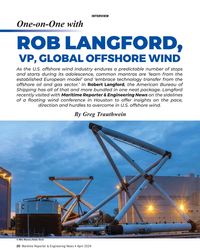 )
April 2024 - Maritime Reporter and Engineering News page: 20
)
April 2024 - Maritime Reporter and Engineering News page: 20INTERVIEW One-on-One with ROB LANGFORD, VP, GLOBAL OFFSHORE WIND As the U.S. offshore wind industry endures a predictable number of stops and starts during its adolescence, common mantras are ‘learn from the established European model’ and ‘embrace technology transfer from the offshore oil and gas
-
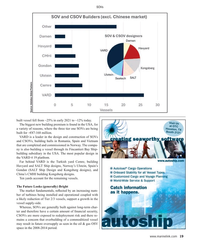 )
April 2024 - Maritime Reporter and Engineering News page: 19
)
April 2024 - Maritime Reporter and Engineering News page: 19SOVs Source: Intelatus Global Partners built vessel fell from ~25% in early 2021 to ~12% today. Visit Us The biggest new building premium is found in the USA, for at OTC Houston, TX a variety of reasons, where the three tier one SOVs are being Booth 2121 built for ~€87-168 million. VARD is a leader in
-
 )
April 2024 - Maritime Reporter and Engineering News page: 18
)
April 2024 - Maritime Reporter and Engineering News page: 18MARKETS & gas activity returns, we anticipate that supply of the vessels The Question of Emissions to offshore wind projects will reduce, driving demand for ad- Given that SOVs and CSOVs operate in a segment target- ditional CSOVs. ing reduced emissions, and many operate in the North Eu- Outside of China
-
 )
April 2024 - Maritime Reporter and Engineering News page: 16
)
April 2024 - Maritime Reporter and Engineering News page: 16MARKETS SOVs – Analyzing Current, Future Demand Drivers By Philip Lewis, Director of Research, Intelatus © Björn Wylezich/AdobeStock t a high-level, there are three solutions to transferring Lower day rate CTVs are often used for daily transfer of technicians from shore bases to offshore wind farms
-
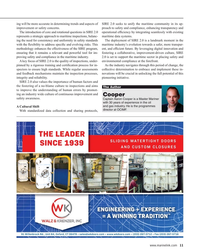 )
April 2024 - Maritime Reporter and Engineering News page: 11
)
April 2024 - Maritime Reporter and Engineering News page: 11ing will be more accurate in determining trends and aspects of SIRE 2.0 seeks to unify the maritime community in its ap- improvement or safety concerns. proach to safety and compliance, enhancing transparency and The introduction of core and rotational questions in SIRE 2.0 operational ef? ciency by
-
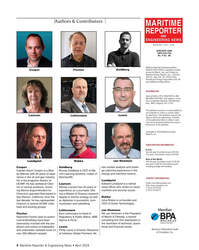 )
April 2024 - Maritime Reporter and Engineering News page: 4
)
April 2024 - Maritime Reporter and Engineering News page: 4Authors & Contributors MARITIME REPORTER AND ENGINEERING NEWS M A R I N E L I N K . C O M ISSN-0025-3448 USPS-016-750 No. 4 Vol. 86 Maritime Reporter/Engineering News (ISSN # 0025-3448) is published monthly Cooper Fischer Goldberg except for March, July, and October by Maritime Activity Reports, Inc.
-
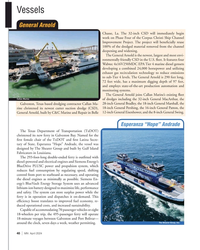 )
April 2024 - Marine News page: 40
)
April 2024 - Marine News page: 40Vessels General Arnold Chasse, La. The 32-inch CSD will immediately begin work on Phase Four of the Corpus Christi Ship Channel Improvement Project. The project will bene? cially reuse 100% of the dredged material removed from the channel deepening and widening. The General Arnold is the newest,
-
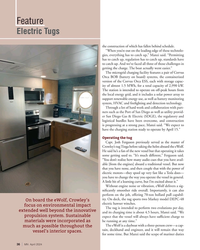 )
April 2024 - Marine News page: 36
)
April 2024 - Marine News page: 36Feature Electric Tugs the construction of which has fallen behind schedule. “When you’re out on the leading edge of these technolo- gies, everything has to catch up,” Manzi said. “Permitting has to catch up, regulation has to catch up, standards have to catch up. And we’ve faced all three of those challenge
-
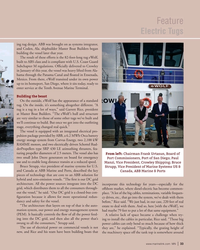 )
April 2024 - Marine News page: 33
)
April 2024 - Marine News page: 33Feature Electric Tugs ing tug design. ABB was brought on as systems integrator, and Coden, Ala. shipbuilder Master Boat Builders began building the vessel later that year. The result of these efforts is the 82-foot-long tug eWolf, built to ABS class and is compliant with U.S. Coast Guard Subchapter M
-
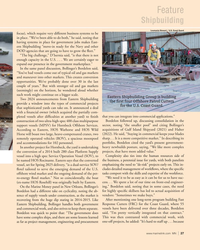 )
April 2024 - Marine News page: 27
)
April 2024 - Marine News page: 27Feature Shipbuilding Loumania Stewart / U.S. Coast Guard focus), which require very different business systems to be in place. “We’ve been able to do both,” he said, noting that having systems in place for government jobs makes East- ern Shipbuilding “move-in ready for the Navy and other DOD agencies
-
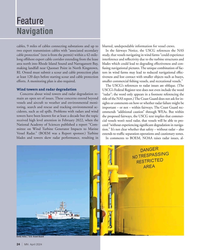 )
April 2024 - Marine News page: 24
)
April 2024 - Marine News page: 24Feature Navigation cables, 9 miles of cables connecting substations and up to blurred, undependable information for vessel crews. two export transmission cables with “associated secondary In the fairways Notice, the USCG references the NAS cable protection” (text is from the permit) within a 42-mile-
-
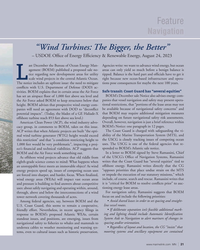 )
April 2024 - Marine News page: 21
)
April 2024 - Marine News page: 21Feature Navigation “Wind Turbines: The Bigger, the Better” – USDOE Of? ce of Energy Ef? ciency & Renewable Energy, August 24, 2023 ast December the Bureau of Ocean Energy Man- Agencies write: we want to advance wind energy, but ocean agement (BOEM) published a proposed sale no- areas can only yield so
-
 )
February 2024 - Maritime Reporter and Engineering News page: 44
)
February 2024 - Maritime Reporter and Engineering News page: 44Tech Files Latest Products & Technologies MarineShaft Yanmar Hydrogen MarineShaft specializes in urgent re- Fuel Cell AIP pair/replacement of damaged rudder and Yanmar Power Technology Co., Ltd. propeller equipment along with many (Yanmar PT), a subsidiary of Yanmar on-site repair services. MarineShaft
-
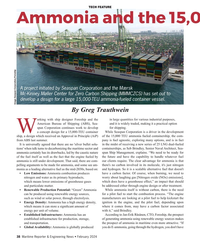 )
February 2024 - Maritime Reporter and Engineering News page: 38
)
February 2024 - Maritime Reporter and Engineering News page: 38TECH FEATURE Ammonia and the 15,00 A project initiated by Seaspan Corporation and the Mærsk Mc-Kinney Møller Center for Zero Carbon Shipping (MMMCZCS) has set out to develop a design for a large 15,000-TEU ammonia-fueled container vessel. Image Seaspan Corporation/Foreship By Greg Trauthwein orking with
-
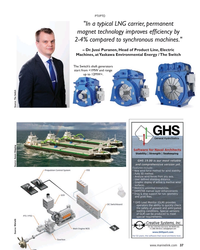 )
February 2024 - Maritime Reporter and Engineering News page: 37
)
February 2024 - Maritime Reporter and Engineering News page: 37PTI/PTO "In a typical LNG carrier, permanent magnet technology improves ef? ciency by 2-4% compared to synchronous machines." – Dr. Jussi Puranen, Head of Product Line, Electric Machines, at Yaskawa Environmental Energy / The Switch The Switch’s shaft generators start from <1MW and range up to 12MW+.
